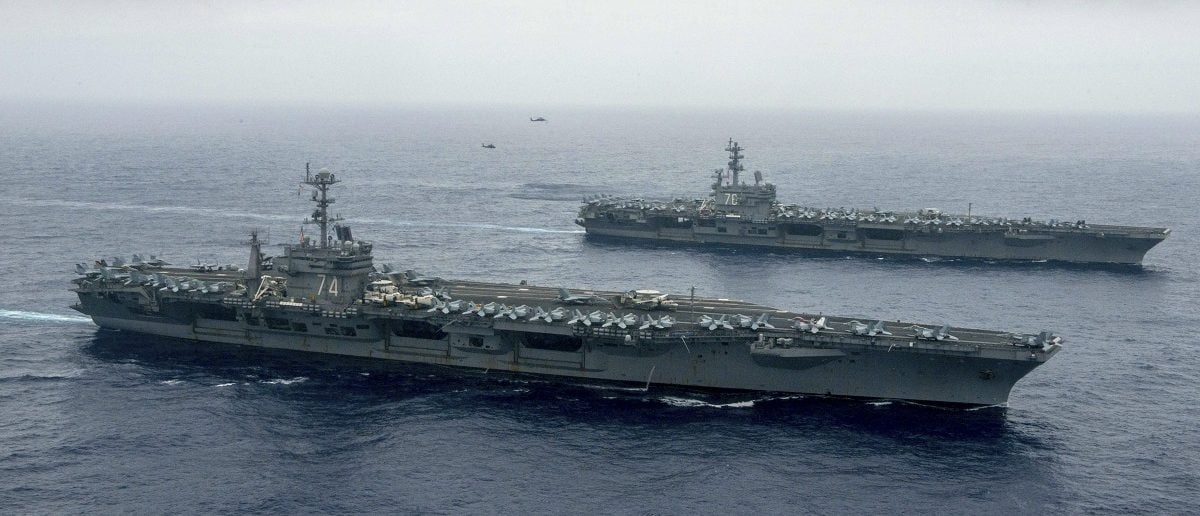By RYAN PICKRELL
 The Nimitz-class aircraft carriers USS John C. Stennis (CVN 74), and USS Ronald Reagan (CVN 76) (rear) conduct dual aircraft carrier strike group operations in the U.S. 7th Fleet area of operations in support of security and stability in the Indo-Asia-Pacific in Philippine Sea on June 18, 2016.
The Nimitz-class aircraft carriers USS John C. Stennis (CVN 74), and USS Ronald Reagan (CVN 76) (rear) conduct dual aircraft carrier strike group operations in the U.S. 7th Fleet area of operations in support of security and stability in the Indo-Asia-Pacific in Philippine Sea on June 18, 2016.
 The Nimitz-class aircraft carriers USS John C. Stennis (CVN 74), and USS Ronald Reagan (CVN 76) (rear) conduct dual aircraft carrier strike group operations in the U.S. 7th Fleet area of operations in support of security and stability in the Indo-Asia-Pacific in Philippine Sea on June 18, 2016.
The Nimitz-class aircraft carriers USS John C. Stennis (CVN 74), and USS Ronald Reagan (CVN 76) (rear) conduct dual aircraft carrier strike group operations in the U.S. 7th Fleet area of operations in support of security and stability in the Indo-Asia-Pacific in Philippine Sea on June 18, 2016.Chinese cyber criminals attempted to hack a U.S. aircraft carrier in the South China Sea a day before a tribunal discredited its claims to the area, according to the Financial Times.
The hackers sent an infected document resembling an official message to foreign government officials visiting the USS Ronald Reagan, a Nimitz-class, nuclear-powered aircraft carrier.
The message contained Enfal malware designed to break through security systems and possibly collect information on maneuvers and policies.
This type of malware can also download additional viruses.
The attack occurred July 11, one day before the Permanent Court of Arbitration at The Hague ruled against China’s vast claims to the South China Sea.
The attack occurred July 11, one day before the Permanent Court of Arbitration at The Hague ruled against China’s vast claims to the South China Sea.
At the time, the USS Ronald Reagan was conducting security patrols in the South China Sea.
The U.S. Navy said that the hackers were unsuccessful.
The U.S. Navy said that the hackers were unsuccessful.
The USS Ronald Reagan’s classified information was not compromised by the attack.
At the moment, there is no evidence indicating that the Chinese government is behind the attack.
At the moment, there is no evidence indicating that the Chinese government is behind the attack.
The Chinese-based group, according to cyber security firm FireEye, has also launched attacks against U.S. and Vietnamese national defense networks.
Cyber attacks were common around the time of the arbitration tribunal’s ruling.
Cyber attacks were common around the time of the arbitration tribunal’s ruling.
Within hours of the ruling, distributed denial of services (DDoS) attacks knocked 68 national and local government websites in the Philippines offline.
Chinese hackers breached airport broadcasting systems in Hanoi and Ho Chi Minh City in late July and aired messages critical of the maritime claims of the Philippines and Vietnam’s maritime claims.
Cyber crimes have actually been a part of the South China Sea row for years.
Chinese hackers breached airport broadcasting systems in Hanoi and Ho Chi Minh City in late July and aired messages critical of the maritime claims of the Philippines and Vietnam’s maritime claims.
Cyber crimes have actually been a part of the South China Sea row for years.
During the dispute over China’s placement of an oil rig in disputed waters, Chinese hackers used “spear-phishing” attacks like the one used against the USS Ronald Reagan to target Vietnamese government and military systems.
These attacks successfully compromised a Vietnamese intelligence agency, leading to the illicit disclosure of military secrets.
Chinese cyber criminals did the same in response to Vietnamese arms acquisition later that year.
The behavior of China’s cyber criminals indicates that the battle for the South China Sea is not being solely fought at sea.
The behavior of China’s cyber criminals indicates that the battle for the South China Sea is not being solely fought at sea.
Aucun commentaire:
Enregistrer un commentaire